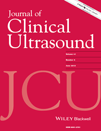Antenatal sonographic appearance of a large orbital encephalocele: A case report and differential diagnosis of orbital cystic mass
Corresponding Author
Ahmed Ahmed MD, MSc, RDMS
Department of Obstetrics and Gynecology, Maimonides Medical Center, Brooklyn, NY
Correspondence to: A. AhmedSearch for more papers by this authorRehab Noureldin MD, PhD
Department of Obstetrics and Gynecology, Alexandria University, Alexandria, Egypt
Search for more papers by this authorMohamed Gendy MD
Department of Ophthalmology, Northwestern University, Feinberg School of Medicine, Chicago, IL
Search for more papers by this authorSharif Sakr MD, MSc
Department of Obstetrics, Gynecology and Reproductive sciences Yale University, School of Medicine, New Haven, CT
Search for more papers by this authorMahmoud Abdel Naby MD, MSc, PhD
Department of Obstetrics and Gynecology, Alexandria University, Alexandria, Egypt
Search for more papers by this authorCorresponding Author
Ahmed Ahmed MD, MSc, RDMS
Department of Obstetrics and Gynecology, Maimonides Medical Center, Brooklyn, NY
Correspondence to: A. AhmedSearch for more papers by this authorRehab Noureldin MD, PhD
Department of Obstetrics and Gynecology, Alexandria University, Alexandria, Egypt
Search for more papers by this authorMohamed Gendy MD
Department of Ophthalmology, Northwestern University, Feinberg School of Medicine, Chicago, IL
Search for more papers by this authorSharif Sakr MD, MSc
Department of Obstetrics, Gynecology and Reproductive sciences Yale University, School of Medicine, New Haven, CT
Search for more papers by this authorMahmoud Abdel Naby MD, MSc, PhD
Department of Obstetrics and Gynecology, Alexandria University, Alexandria, Egypt
Search for more papers by this authorAbstract
Orbital meningoceles and encephaloceles are rare extracranial extensions of the brain and meninges with or without direct communication between the central nervous system and the abnormal mass. We reported a rare case of large fetal orbital encephalocele; the diagnosis was suspected initially by prenatal ultrasound and confirmed by postnatal MRI and CT scans. The differential diagnosis of an intrauterine fetal cystic orbital mass includes orbital teratoma, epidermoid inclusion cysts, hemangioma or lymphangioma, congenital cystic eye, dacryocystocele, and orbital cephalocele. © 2012 Wiley Periodicals, Inc. J Clin Ultrasound, 41:327–331, 2013
REFERENCES
- 1Goldstein RB, LaPidus AS, Filly RA. Fetal cephaloceles: diagnosis with US. Radiology 1991; 180: 803.
- 2Mahapatra AK, Gupta PK, Dev EJ. Posterior fontanelle giant encephalocele. Pediat Neurosurg 2002; 36: 40.
- 3Hoving EW. Nasal encephaloceles. Childs Nerv Syst 2000; 16: 702.
- 4Budorick NE, Pretorius DH, McGahan JP, et al. Cephalocele detection in utero: sonographic and clinical features. Ultrasound Obstet Gynecol 1995; 5: 77.
- 5Mueller GM, Weiner CP, Yankowitz J. Three-dimensional ultrasound in the evaluation of fetal head and spine anomalies. Obstet Gynecol 1996; 88: 372.
- 6Shields JA, Shields CL. Orbital cysts of childhood—classification, clinical features, and management. Surv Ophthalmol 2004; 49: 281.
- 7Guthoff R, Klein R, Lieb WE. Congenital cystic eye. Graefes Arch Clin Exp Ophthalmol 2004; 242: 268.
- 8Tsai PY, Chang CH, Chang FM. Prenatal diagnosis of the fetal frontal encephalocele by three-dimensional ultrasound. Prenat Diagn 2006; 26: 378.
- 9Chatterjee MS, Bondoc B, Adhate A. Prenatal diagnosis of occipital encephalocele. Am J Obstet Gynecol 1985; 153: 646.
- 10Pilu G. Ultrasound evaluation of the fetal neural axis. In: PW Callen, editor. Ultrasonography in Obstetrics and Gynecology 5th ed. Philadelphia: Elsevier Health Sciences; 2008. p 371.
- 11Garcia LM, Castro E, Foster JA, et al. Colobomatous microphthalmia and orbital neuroglial cyst: case report. Ophthalmic Genet 2002; 23: 37.
- 12Terry A, Patrinely JR, Anderson RL, et al. Orbital meningoencephalocele manifesting as a conjunctival mass. Am J Ophthalmol 1993; 115: 46.
- 13Lopez P, Gonzalez D, Medina M, et al. First trimester abnormal profile and facial angle. Early features of anterior cephalocele. Int Soc Perinat Obstet 2010; 23: 1260.
- 14Monteagudo AT-T, I.E. http://www.thefetus.net/sections/articles/Central_nervous_system/Cephalocele. 1992.
- 15Sharony R, Raz J, Aviram R, et al. Prenatal diagnosis of dacryocystocele: a possible marker for syndromes. Int Soc Ultrasound Obstet Gynecol 1999; 14: 71.
- 16Petrikovsky BM, Kaplan GP. Fetal dacryocystocele: comparing 2D and 3D imaging. Pediatr Radiol 2003; 33: 582.
- 17Sepulveda W, Wojakowski AB, Elias D, et al. Congenital dacryocystocele: prenatal 2- and 3-dimensional sonographic findings. J Ultrasound Med 2005; 24: 225.
- 18Lembet A, Bodur H, Selam B, et al. Prenatal two- and three-dimensional sonographic diagnosis of dacryocystocele. Prenat Diagn 2008; 28: 554.
- 19D'Addario V, Pinto V, Anfossi A, et al. Antenatal sonographic diagnosis of dacryocystocele. Acta Ophthalmol Scand 2001; 79: 330.
- 20Bianchini E, Zirpoli S, Righini A, et al. Magnetic resonance imaging in prenatal diagnosis of dacryocystocele: report of 3 cases. J Comp Assist Tomograph 2004; 28: 422.
- 21Kapoor V, Flom L, Fitz CR. Oropharyngeal fetus in fetu. Pediatr Radiol 2004; 34: 488.
- 22Chaudhry IA, Shamsi FA, Elzaridi E, et al. Congenital cystic eye with intracranial anomalies: a clinicopathologic study. Int Ophthalmol 2007; 27: 223.
- 23Chaudhry IA, Arat YO, Shamsi FA, et al. Congenital microphthalmos with orbital cysts: distinct diagnostic features and management. Ophthalmic Plast Reconstr Surg 2004; 20: 452.
- 24Kavanagh MC, Tam D, Diehn JJ, et al. Detection of a congenital cystic eyeball by prenatal ultrasound in a newborn with Turner's syndrome. Br J Ophthalmol 2007; 91: 559.
- 25Mehta RC, Marks MP, Levin PS. Aicardi's syndrome: MR appearance of unusual orbital and ventricular cystic lesions. AJR Am J Roentgenol 1993; 160: 601.
- 26Herman TE, Siegel MJ. Aicardi syndrome with probable intraorbital cystic encephalocele. Calif Perinatal Assoc 2002; 22: 93.
- 27Nielsen KB, Anvret M, Flodmark O, et al. Aicardi syndrome: early neuroradiological manifestations and results of DNA studies in one patient. Am J Med Genet 1991; 38: 65.
- 28Elia D, Garel C, Enjolras O, et al. Prenatal imaging findings in rapidly involuting congenital hemangioma of the skull. Int Soc Ultrasound Obstet Gynecol 2008; 31: 572.




